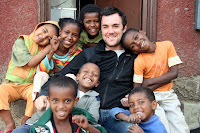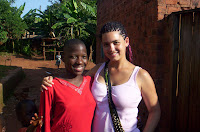We love your work Carolyn!
As Carolyn Maskens explains, when she set out to raise a bit of money to help improve the lives of the children at an orphanage in the East African nation of Kenya, she and her Kenyan friends were amazed by the response.

I graduated from Queen’s this spring with an honours degree in Life Sciences. I’d like to share the you an exciting story of what individual action and dreams can accomplish. In just 9 months I raised $20,500 for an orphanage in Kenya. I’m hoping that by sharing my story with other members of the Queen’s community, it will inspire people to consider their own potentials.
In May 2008, when I was 22 and going into my final year at Queen’s, I volunteered with an organization called Global Volunteer Network, which assigned me to work at an orphanage in Kenya. While I was there, the children suffered from an outbreak of a fungal infection. Many of them were covered in open, oozing sores, and a visit I made to the medical clinic would change my life forever. I’d never seen children suffering from such ailments as a result of malnutrition.
Returning home to Peterborough, Ontario, I founded Kenya Hope 2009, a fundraising initiative for Shelter orphanage, which is located 40 km from Nairobi, the Kenyan capital. The director of Shelter, Mary Muiruri and I decided the best way to improve nutrition would be to provide milk for the children. With that in mind, I started out with a small donations box in my father’s office. This initiative soon grew into a web site, was featured in the Peterborough Examiner newspaper, and gained the support of St.Catherine Elementary School. My initial goal was to raise $5,000 for the orphanage to donate two dairy cows and support them for one year.
I began fundraising in August of last year, but by Christmas I’d almost reached my goal, and so I upped my target to $8,000. One thing led to another, and by the time I left for Kenya this May, Kenya Hope had received more than $20,500 in donations. I was amazed at how much I’d been able to accomplish with only the assistance of my family and the people in my hometown whose
generosity has made my dream a reality for the orphanage.
Mary Muiruri was blown away when I returned with four times the amount of money that I’d hoped to raise. She couldn’t believe how much money Canadians had donated.
Seeing the smiling faces of the children I’d met on my previous visit was heartwarming and made my efforts seem so much more worthwhile. The youngsters all recognized me and were surprised and thrilled that I’d come back.
Getting down to business, Mary and I set up a budget and devised a plan to make the best possible use of the donated funds. Our first priority was the Milk Project, which would bring milk to the orphanage. I just couldn’t wait to see this become a reality.
We used some of the money, $2,900, to buy two big, beautiful Holstein cows from a local livestock breeder. These two animals were soon providing the children with a total of more than 50 litres of milk each day.

The children at St. Catherine Elementary School in Peterborough, a large contributor to the Kenya Hope 2009 fundraising campaign, named one of the cows “Hope” based on the motto of Shelter: “Giving life a new hope.”
I thought it would be appropriate to name the other cow “Tumaini” (pronounced “Too-my-een-ie) which means hope in Kiswahili (one of the two national languages of Kenya, English being the other).
The cow we named Hope produces 22 litres of milk each day, while Tumaini produces 38. The animals are milked three times daily – at 4 am, 1 pm, and 6 pm due to the high volume of milk production. The milk is then boiled for 30 minutes prior to the children drinking a glass of warm milk in the evening. They absolutely love it.
As the temperature drops in the evening, it becomes quite cool, and having a warm glass of milk before bed is a marvelous treat for the kids. After being offered a glass multiple times, I tried a sip for myself and was shocked at how sweet it is. The milk tastes as if sugar has been added to it. It’s not bitter and is surprisingly delicious.
 In case you’re wondering, dairy meal is a staple of the cows’ diet, and there was enough money to provide it for the coming year. My new goal for 2010 is to continue with fundraising in order to sustain the milk project beyond next summer. I now hope to raise $5,000 for the purchase of dairy meal for the following year and to cover the cost of breeding the cows so the children can continue to have milk.
In case you’re wondering, dairy meal is a staple of the cows’ diet, and there was enough money to provide it for the coming year. My new goal for 2010 is to continue with fundraising in order to sustain the milk project beyond next summer. I now hope to raise $5,000 for the purchase of dairy meal for the following year and to cover the cost of breeding the cows so the children can continue to have milk.Fundraising efforts on behalf of the Shelter are ongoing, and individuals can view the sponsored projects by visiting the website www.kenyahope2009.com.
I’m also exploring the possibility of publishing a children’s book based on Tumaini and the orphans in hope of providing long term support for Shelter through its sale.
Other projects that were developed and completed while I was at Shelter included starting a library. We bought several hundred books, painted bookshelves, finished the shelves with lockable glass sliding doors, brought electricity to the library and built a large table at which the children could read and study. Additionally, we bought one tonne of food. This consisted of a month’s supply of maize, maize flour, porridge flour, rice, and beans. The farm project entailed digging a 100-metre trench, two feet wide by three feet deep, to expand an irrigation system to Shelter’s garden, purchasing 100 metres of plastic piping, a variety of seeds and fertilizers. A health and first aid supply initiative was also initiated and designed to take care of minor complications and provide vitamins for the malnourished children.
As you can imagine, this has been a very exciting year for me, my community, and for the children at the Shelter. I’m delighted to share this story with you and other members of the Queen’s community. I hope you’ll find it as inspirational to read about as I’ve found it to be involved with. Oh yes, and all donations are most welcome and go directly to Shelter and will be put to good use.










